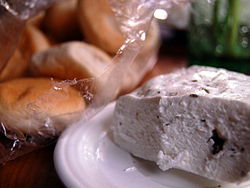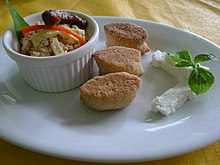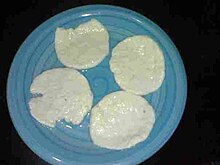Kesong puti
| Kesong puti | |
|---|---|
 | |
| Country of origin | Philippines |
| Source of milk | Carabao,Goat,Cow |
| Pasteurised | Yes |
| Texture | Soft |
| Aging time | None |
Kesong putiis aFilipinosoft, unaged, whitecheesemade from unskimmedcarabao milkand salt curdled withvinegar,citrusjuices, or sometimesrennet.It can also be made withgoatorcow milk.It has a mild salty and tart flavor. When an acidifying agent is used, it resemblesqueso blancoorpaneer.When rennet is used, it resemblesbuffalo mozzarella.Moisture content can also vary, ranging from almost gelatinous to pressed and firm. It can be eaten as is, paired with bread (usuallypandesal), or used in various dishes inFilipino cuisine.It is usually sold wrapped inbanana leaves.[1]
The name, also spelledquesong puti,isTagalogfor "white cheese" and is its name in the provinces ofLagunaandBulacan.InCaviteit is known askesilyo(alsokasilyoorquesillo); while in northernCebuit is known asqueseoorkiseyo.[2]
Etymology
[edit]Kesong putiis fromSpanishqueso( "cheese" ) with theTagalogencliticsuffix-ng,and Tagalogputi( "white" ). In other parts of the Philippines,CaviteñokesilyoorkasilyoandCebuanoqueseoorkiseyo,are all nativized spellings of Spanishquesillo( "little cheese" ).[2]
Production
[edit]
Mostkesong putiis made by directacidification,similar to numerous other cheeses likequeso blanco,paneer,ricotta,mascarpone.[3]It is usually made withcarabao milk,but it can also usegoatorcow milk,though the latter has lower yields.[4][5]
The most common way of making homemadekesong putiis by heating (but not boiling) fresh strained carabao milk with one to four teaspoons of salt for about ten to fifteen minutes while stirring constantly. The ideal temperature is around 72 to 75 °C (162 to 167 °F), as long as it does not reach 95 °C (203 °F) and above. Higher temperatures will denature the proteins, resulting in slower or even no curdling. This alsopasteurizesthe milk, destroyingpathogensand allowing the cheese to last longer. Around a fourth of a cup ofvinegarorcitrusjuices (or both) are then added to induce coagulation. It is left to curdle for around 30 minutes to an hour. Thecurdsare strained with acheesecloth(katsa) leaving the soft gelatinous-like version ofkesong puti.It can be further pressed and molded to squeeze out morewheyif desired.[4][6][7][8][9]In commercial versions, the salt is usually added after the curdling either through manual mixing or by soaking the cheese in weakbrinesolutions.[10]
An alternate way of makingkesong putiis withrennetdissolved in a small amount of water. The rennet can either be vegetable-based or fromruminantstomachs. The steps are similar to the vinegar or citrus method but requires that the milk be cooled after it is taken off the heat, ideally to 40 to 45 °C (104 to 113 °F). This is because rennet is deactivated at higher temperatures, while lower temperatures result in slow or no coagulation. Like in the previous method, it is left to coagulate for 30 minutes to an hour. The curds are strained then cut into small cubes and left to stand for another 15 minutes to allow more moisture to seep out. This method results in more curds and a firmer type of cheese once pressed. It is the method used by thePhilippine Carabao Centerkesong puti.[9][11]
Kesong putimade with rennet is similar to theItalianmozzarella di bufala.It lacks the sour vinegary smell that usually characterizes the vinegar or citrus versions.[12]
Culinary uses
[edit]
Kesong putiis usually sold wrapped inbanana leaves.It has a mildly salty and tart flavor and ideally has little or no odor. It can be eaten as is, either fresh or grilled on a pan.[11][13]It is also commonly eaten with bread orkakaninrice cakes, includingpandesal,puto,andbibingka,It can also be used in various dishes inFilipino cuisine;including dishes likepaella negraandginataangpakô.[5][14][1]
Kesong putihas ashelf lifeof only around a week. It depends on the amount of salt used as well as the consistency of the cheese. Softer cheese spoil faster than firmer versions. It can be extended to about two weeks to a month if packaged correctly and refrigerated. However, it should never be frozen as it will form ice crystals that damage the smooth texture.[9][11][15]
Variants
[edit]There are four main regions producing variants ofkesong putithat probably originated independently:Laguna,Cebu,Cavite,andBulacan.The following are the most prevalent production techniques for commercialkesong putiamong the regions:[10]
Laguna
[edit]Lagunakesong putiorquesong putiis originally fromSanta Cruz, Laguna.Its production is centered in the towns of Santa Cruz,Pagsanjan,andLumban,with the milk used coming from neighboring towns (mostly from Lumban andJalajala). Lagunakesong putitraditionally use rennet from carabao or cowabomasum.It undergoeslactic acidfermentationduring the process. The salt is added afterwards and mixed by hand until the texture becomes smooth. It is similar to the Cebu version and is firmer than the Cavite and Bulacan version.[10]Santa Cruz celebrates an annualKesong Puti Festival.[16][17][18]
Cebu
[edit]
Cebuanoqueseoorkiseyoproduction is centered on the town ofCompostelaand the city ofDanao.It is very similar to the Laguna version and is made using the same processes. It differs only in thatqueseotypically use more salt and the molds are lined withmuslincloth. The muslin cloth may be pressed with a weight. It is a fermented cheese and is also usually firm, like the Laguna version.[10]The town of Compostela celebrates an annualQueseo Festival.[19][20][21]
Cavite
[edit]Caviteñoquesillo,kesilyo,orkasilyoproduction is centered in the cities ofGeneral TriasandCavite,and the municipality ofTanza.It uses vinegar as the coagulant. It is not a fermented cheese, unlike the Laguna and Cebu versions. Salt is added to the milk beforehand. A small amount of vinegar is then heated to around 60 °C (140 °F) in a small, clay pot (palayók) and the milk added and stirred until curds form. The curds are strained and molded in small cups and then further soaked in a weakbrinesolution. The resulting cheese has a softer consistency in comparison to the Laguna and Cebu versions.[10]
Bulacan
[edit]Bulacankesong putiproduction is centered in the towns ofSanta Maria,Meycauayan,andSan Miguel.It is similar to the Caviteño version in that it is not a fermented cheese and primarily use vinegar. It differs in that more vinegar is used and it is not heated while curdling. The curds are molded and then soaked in a weak brine solution.[10]
See also
[edit]- Tibok-tibok
- Pastillas
- Paneer– Type of fresh cheese commonly used in Indian cuisine
- List of cheeses
- List of water buffalo cheeses
References
[edit]- ^abPonseca, Nicole & Trinidad, Miguel (2018).I Am a Filipino: And This Is How We Cook.Artisan Books.ISBN9781579658823.
{{cite book}}:CS1 maint: multiple names: authors list (link) - ^abEdgie Polistico (2017).Philippine Food, Cooking, & Dining Dictionary.Anvil Publishing, Incorporated.ISBN9786214200870.[permanent dead link]
- ^Chandan, Ramesh C. (2007). "Cheese Varieties Made by Direct Acification of Hot Milk". In Hui, Y.H.; et al. (eds.).Handbook of Food Products Manufacturing: Health, Meat, Milk, Poultry, Seafood, and Vegetables.John Wiley & Sons. p. 637.ISBN9780470049648.
- ^ab"Homemade White Cheese (Kesong Puti) Using Fresh Milk".Manila Mom Cooks.June 22, 2017.RetrievedDecember 21,2018.
- ^ab"Kesong puti dishes, ihahain sa 'Pinas Sarap'".GMA News Online.October 9, 2017.RetrievedDecember 21,2018.
- ^"What Is The Queseo Of Compostela?".The I ♥ Cebu blog by Peanut Browas.RetrievedDecember 21,2018.
- ^"How to Make Kesong Puti (Filipino White Cheese) using Vinegar".Business Diary Philippines.February 4, 2018.RetrievedDecember 21,2018.
- ^de Guzman, Jun Jun (February 12, 2017)."Kesong Puti (White Cheese) Recipe".Yummy.ph.RetrievedDecember 21,2018.
- ^abc"Factors Affecting the Yield Recovery and Quality of Kesong Puti"(PDF).IASK(B-02-2017). Philippine Carabao Center, Department of Agriculture, Republic of the Philippines. 2017.
- ^abcdefSanchez, Priscilla C. (2008).Philippine Fermented Foods: Principles and Technology.University of the Philippines Press. pp. 238–241.ISBN9789715425544.
- ^abc"How to Make Kesong Puti, Carabao White Cheese".FoodRecap.RetrievedDecember 22,2018.
- ^"Kesong Puti & Kalabaw Mozzarella / Carabao Milk Cheeses".Market Manila.April 3, 2005.RetrievedDecember 22,2018.
- ^"Quesong Puti / Filipino White Cheese".mm2.January 29, 2017.RetrievedDecember 22,2018.
- ^Garcia, Bianca (May 6, 2011)."Kesong Puti: a Cheese I've Loved My Whole Life, Thanks To My Mom".Confessions of a Chocoholic.RetrievedDecember 21,2018.
- ^"Kesong Puti (Native White Cheese)".Laguna Travel Guide.RetrievedDecember 22,2018.
- ^"Sta. Cruz celebrates 10th Kesong Puti Festival".Provincial Government of Laguna.RetrievedDecember 22,2018.
- ^Caparas, Kheem (May 23, 2012)."Kesong Puti Festival: White Cheese Everywhere!".Vigattintourism.RetrievedDecember 22,2018.
- ^"Ang Kesong Puti ng Sta. Cruz".WowLaguna.January 11, 2012.RetrievedDecember 22,2018.
- ^"What Is The Queseo Of Compostela?".The I ♥ Cebu blog by Peanut Browas.RetrievedDecember 22,2018.
- ^"Queseo Festival".Municipality of Compostela.RetrievedDecember 22,2018.
- ^Mendoza, Norman V. (July 10, 2014)."Compostela gears up for fiesta".Cebu Daily News.RetrievedDecember 22,2018.

